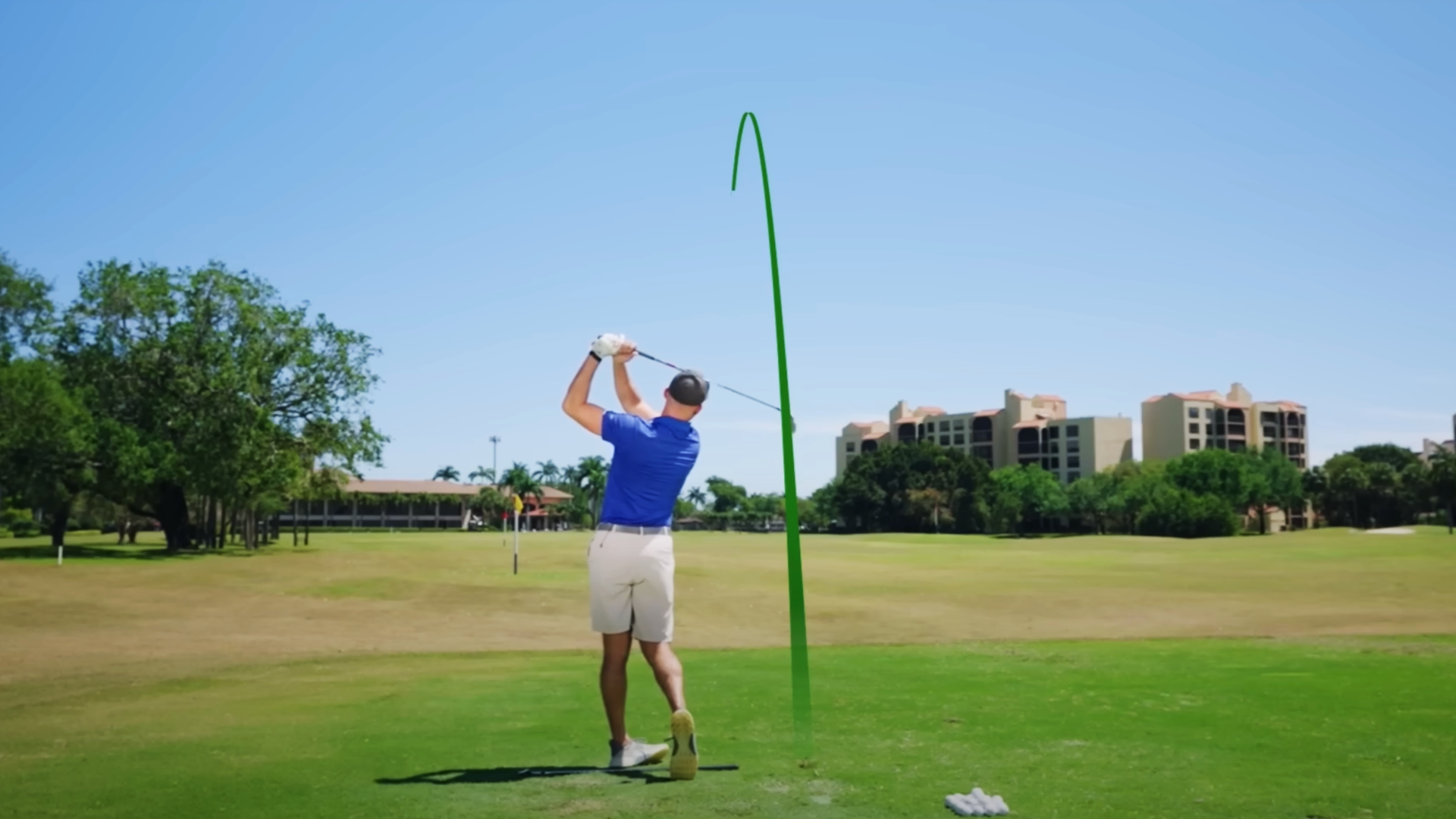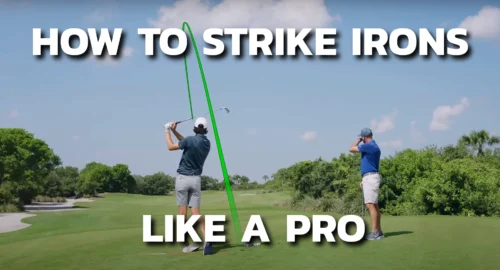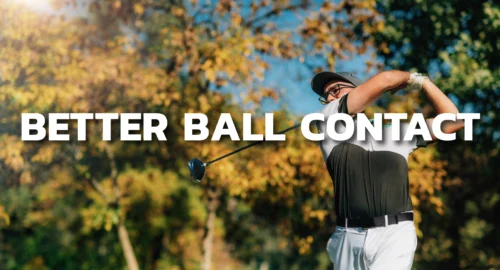
One of the most important metrics is swing speed — the speed at which a golfer swings the club. Swing speed can vary depending on the club in hand, with drivers typically seeing higher speeds than irons. As data collection in golf continues to improve, our ability to access key performance metrics has followed suit.
It is essential to understand when to maximize swing speed for distance and when to dial it back for better control. If you’re new to golf swing speed and want to learn how it affects your game, you’re in the right place.
What is Golf Swing Speed?
Golf swing speed is how fast a golfer can swing a club. The swing speed is measured during the downswing as the club travels through the hitting zone.
A golfer’s swing speed directly impacts how far the golf ball will travel.
Players with faster swing speeds will be able to generate more speed than those with slower swing speeds. The faster you can swing a club, the easier it is to create ball speed and total distance.
For golfers looking to hit longer drives or increase yardage on approach shots, the swing speed is the perfect place to start.
One thing all golfers need to remember about swing speed is that even though it helps to generate distance and power, more swing speed can also lead to difficulty with control. Most golfers have to find a balance between swing speed and accuracy.
Swing Speed vs. Ball Speed
Golfers talk about two different speeds: swing speed and ball speed. Ball speed is the speed at which the golf ball travels directly after being struck by the clubface. It is not the same as swing speed, yet it is influenced by swing speed and how good a strike you make with the ball.
A higher swing speed should result in a higher ball speed if the ball is struck in the center of the clubface.
Quality of contact is very important in ball speed but won’t impact swing speed numbers. The more efficient a golfer’s swing is, the easier it is for them to generate ball speed.
For example, a 100 mph swing speed golfer may generate a ball speed of 150 mph with a good strike. With a poor strike, the ball speed may be considerably lower.
Professional golfers have ball speeds in the 160-180 mph range, whereas male amateur golfers are usually in the 130-150 mph range. Female amateurs are typically in the 100-120 mph range for ball speed.
Swing Speed vs. Clubhead Speed
The terms clubhead speed and swing speed are typically used interchangeably. Technically, one refers to the speed of the swing and the other to the speed of the clubhead, but they should be the same. You’ll hear golfers refer to both swing and clubhead speeds and expect the same general meaning.
What Is an Average Swing Speed?
Once you understand what swing speed is, it’s important to know the average swing speeds of various golfers. Knowing your swing speed can help you estimate the total distances you should be hitting, and it can also help you determine which golf shafts you need in your clubs.
Typically, we look at golfers in four different categories. These include beginner, intermediate, advanced, and tour professionals. As you move from the beginner stages in golf up to the Tour Professional stage, you’ll see that the average swing speed numbers continue to increase.
Average Swing Speed by Player Level
| Player Level | Average Swing Speed (Driver) |
|---|---|
| Beginner | 70-85 mph |
| Intermediate | 85-100 mph |
| Advanced | 100-110 mph |
| Tour Professional | 110+ mph |
Why Does Swing Speed Matter?
Can you be a great golfer and still have a lower average swing speed? Absolutely. However, any great golfer will tell you that the ability to generate distance in golf is a distinct advantage. With more swing speed, hitting longer shots and getting the ball closer to the hole is easier.
To increase your swing speed and achieve a smoother, more consistent tempo you might want to try out some golf training aids. Our Pendulum Swing Trainer is a great, affordable option for you to practice without a club anywhere, anytime.
You can add 4-8 MPH to your swing speed with consistent practice!

High vs. Low Swing Speed – What’s Best?
It may seem like high swing speed is better than low swing speed. However, there are times when high swing speed can be a problem for some players.
A golfer who hits a shot with a misaligned clubface at 110 mph will see a much different result than the 70 mph swing speed who hits this same shot. The player with the higher swing speed may see a drive that has missed the fairway significantly, whereas the slower swing speed golfer may just have missed the center of the fairway.
Every golfer must find a balance between when it makes sense to swing at full speed, and when control is the better option.
The Impact of Swing Speed on Different Clubs
You’ll notice that the swing speed in a driver is almost always higher than it is with irons. Irons are heavier golf clubs, and players cannot swing them as fast. In addition, the goal with shorter irons and wedge is more about accuracy than it is generating more distance. Here is a general look at how swing speed affects performance across various clubs.
| Club Type | Average Swing Speed (mph) |
|---|---|
| Driver | 105 |
| 5 Iron | 80 |
| 7 Iron | 75 |
| 9 Iron | 70 |
Driver
The driver is where you’ll want your fastest swing speeds. The higher the swing speed in the driver, the more distance you’ll get. The key here is to ensure the club head is square at impact to ensure the shot goes straight. Some golfers struggling with slicing or hooking have to slow their swing speed down to hit straight shots.
Irons
With iron shots, swing speed will also impact distance, but more importantly, it will play into distance control and trajectory. Higher swing speed players can hit shots slightly higher than those with slower swing speed. When golfers take a little speed off their iron shots, they will see less yardage. This is sometimes used as a strategy to hit shots of varying distances.
Wedges
With wedges, players don’t need to be as concerned with hitting long golf shots; control is more important. Players need a certain amount of speed to generate spin in wedge shots, but controlled swing speed is more important than being able to hit wedges a long way.
Managing Swing Speed for Maximum Performance
As a newer golfer, it can be difficult to determine when it makes sense to increase swing speed and power and when it makes sense to back down and look for better control. Here are a few examples of times you should be maximizing swing speed or pulling back a little.
Use maximum swing speed when:
- Driving on a wide fairway with no trouble
- Tee shots on par 5s; take advantage of the longer distances to set up a shorter approach for your second shot.
- Long approach shots on par 5s with no trouble in front of the green
Use controlled swing speed when:
- Approach shots to narrow fairways or greens, prioritize accuracy
- Tee shots on holes with water hazards or out-of-bounds areas
- Approach shots to smaller greens where accuracy is more important
- In windy conditions, in strong winds, a smoother, controlled swing may help maintain better control over ball flight
Swing Speed and Its Impact on Shot Distance
Knowing how fast you swing the golf club can also help you determine if you are hitting your golf shots at an appropriate distance. This chart shows the average swing speed for a golfer and the estimated distance for the driver, 7 iron, and wedge. These distances will vary based on the equipment used and the quality of the strike.
| Swing Speed (mph) | Estimated Driver Distance | Estimated 7-Iron Distance | Estimated Wedge Distance |
|---|---|---|---|
| 70-80 mph | 180-220 yards | 120-140 yards | 70-90 yards |
| 80-90 mph | 180-220 yards | 140-160 yards | 90-110 yards |
| 90-100 mph | 250-280 yards | 160-180 yards | 110-130 yards |
| 100-110 mph | 280-310 yards | 180-200 yards | 130-150 yards |
| 110+ mph | 310+ yards | 200+ yards | 150+ yards |
How to Increase Swing Speed Safely
If you think some extra swing speed could be helpful in your golf game, there are a few ways to go about it. However, if you are not smart about increasing your swing speed, it can throw off your tempo, and you can even injure yourself if you aren’t careful. Here are some ways to increase swing speed safely.
Focus on Body Rotation
Golfers who use their hands, wrists, and arms to swing without incorporating larger muscles like the core and shoulders struggle with generated swing speed. Improving your body rotation and using the larger muscles should help you swing the club faster.
Check your Fundamentals
Even something like your stance and grip can impact your swing speed. Make sure your posture and foot position are correct to maximize your speed. Having a balanced setup is an important step in increasing speed.
Flexibility and Strength Training
The more flexible you can get and the stronger you are, the easier it is to generate speed. Doing stretches to increase your ability to rotate will help increase your swing speed. Strength training and swing speed training can be effective if done specifically for golfers to avoid injury.
Success with Golf Swing Speed
Swing speed is an important term in golf. Although increasing swing speed is a great way to gain power you must go about it correctly. Not every golf shot requires your highest swing speed—especially not when it means you’re sacrificing control and accuracy.
To really bring all your swing mechanics together, check out some of our professional golf training from top rated coaches, like The One Shot Slice Fix and The Smart Distance System.

